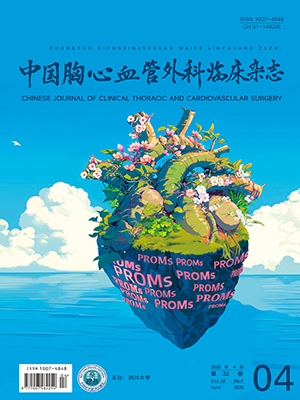Objective To investigate the impact of different modes of cardiopulmonary bypass (CPB) and cerebral perfusion on cerebral protection in patients with Stanford type A aortic dissection (AD). Methods Clinical data of 117 patients with Stanford type A AD who underwent surgical therapy from April 2007 to March 2012 in the First Affiliated Hospital of Harbin Medical University were retrospectively analyzed. All the patients were divided into 3 groups according to different modes of CPB and cerebral perfusion they received. In group 1,45 patients received CPB perfusion through the femoral artery and unilateral or bilateral antegrade selective cerebral perfusion (ASCP) after circulatory arrest. In group 2,38 patients received CPB perfusion through the subclavian artery or innominate artery and unilateral or bilateral ASCP after circulatory arrest. In group 3,34 patients received antegrade and retrograde CPB perfusion through both subclavian artery or innominate artery and femoral artery,and unilateral or bilateral ASCP after circulatory arrest. Postoperative occurrence of transient neurological dysfunction (TND),permanent neurological dysfunction (PND) and influential factors were compared between the 3 groups. Results Incidence of postoperative cerebral complications of group 1 was significantly higher than those of group 2 and 3 (37.77% vs. 13.16% vs. 14.71%,P <0.05). During CPB,cooling time of group 3 was significantly shorter than those of group 1 and 2 (35.56±4.35 vs. 40.00±5.63 and 39.58±6.03,P <0.05). There was no statisticaldifference in other influential factors among the 3 groups (P >0.05). Conclusion Antegrade and retrograde CPB perfusionin combination with ASCP has a smooth and quicker cooling rate,may provide better protection for the spinal cord,kidney and intraperitoneal organs and especially decrease the incidence of postoperative cerebral complications,therefore is proved current best method for organ protection.
Citation:
WANG Baichun,LIU Zonghong,MENG Weixin,SUN Bo,LIU Hongyu.. Different Modes of Cardiopulmonary Bypass and Cerebral Perfusion for Cerebral Protection in Patients with Stanford Type A Aortic Dissection. Chinese Journal of Clinical Thoracic and Cardiovascular Surgery, 2013, 20(5): 529-532. doi: 10.7507/1007-4848.20130167
Copy
Copyright © the editorial department of Chinese Journal of Clinical Thoracic and Cardiovascular Surgery of West China Medical Publisher. All rights reserved
| 1. |
蒙炜, 张尔永, 杨建, 等. 主动脉夹层的外科治疗. 中国胸心血管外科临床杂志, 2009, 16 (1):40-42.
|
| 2. |
孙立忠, 刘志刚, 常谦, 等. 主动脉弓替换加支架“象鼻”手术治疗Stanford A型主动脉夹层. 中华外科杂志, 2004, 42 (13):812-815.
|
| 3. |
尚蔚, 刘楠, 闫晓蕾, 等. A型主动脉夹层手术后早期并发症分析. 心肺血管病杂志, 2011, 30 (3):183-186.
|
| 4. |
孙立忠, 齐瑞东, 朱俊明, 等. 孙氏手术 (Sun's procedure)——复杂型A型主动脉夹层手术治疗的新标准. 中国医药, 2011, 6 (Z2):1-3.
|
| 5. |
Ergin MA, Uysal S, Reich DL, et al. Temporary neurologicaldysfunction after deep hypothermic circulatory arrest:a clinical marker of long-term functional deficit. Ann Thorac Surg, 1999, 67 (6):1887-1890.
|
| 6. |
Krüger T, Weigang E, Hoffmann I, et al. Cerebral protection duringsurgery for acute aortic dissection type A:results of the GermanRegistry for Acute Aortic Dissection Type A (GERAADA). Circulation,2011, 124 (4):434-443.
|
| 7. |
Sun L, Qi R, Zhu J, et al. Repair of acute type A dissection:our experiences and results. Ann Thorac Surg, 2011, 91 (4):1147-1152.
|
| 8. |
Sakurada T, Kazui T, Tanaka H, et al. Comparative experimental study of cerebral protection during aortic arch Reconstruction. Ann Thorac Surg, 1996, 61 (5):1348-1354.
|
| 9. |
Westaby S, Katsumata T, Vaccari G. Arch and descending aortic aneurysms:influence. Of perfusion technique on neurological outcome.Eur J Cardiothorac Surg, 1999, 15 (2):180-185.
|
| 10. |
Hagl C, Ergin MA, Galla JD, et al. Neurologic outcome afterascending aorta-aortic arch operations:effect of brain protectiontechnique in high-risk patients. J Thorac Cardiovasc Surg, 2001, 121(6):1107-1121.
|
| 11. |
Haldenwang PL, Wahlers T, Himmels A, et al. Evaluation of risk factors for transient neurological dysfunction and adverse outcomeafter repair of acute type A aortic dissection in 122 consecutive patients.Eur J Cardiothorac Surg, 2012, 42 (5):115-120.
|
| 12. |
Malvindi PG, Scrascia G, Vitale N. Is unilateral antegrade cerebral perfusion equivalent to bilateral cerebral perfusion for patients undergoing aortic arch surgery ? Interact Cardiovasc Thorac Surg, 2008, 7 (5):891-897.
|
| 13. |
葛振伟, 顾以茼, 谢周良, 等. 双侧序贯顺行性脑灌注在主动脉弓部手术中的神经保护作用. 中国综合临床, 2008, 24 (8):816-818.
|
| 14. |
Strauch JT, Spielvogel D, Lauten A, et al. Axillary artery cannulation:routine use in ascending aorta and aortic arch replacement. Ann Thorac Surg, 2004, 78 (1):103-108.
|
| 15. |
Tiwari KK, Murzi M, Bevilacqua S, et al. (ascending aortic cannu-ation or peripheral arterial cannulation) is better for acute type A aorticdissection surgery ? Interact Cardiovasc Thorac Surg, 2010, 10 (5):797-802.
|
- 1. 蒙炜, 张尔永, 杨建, 等. 主动脉夹层的外科治疗. 中国胸心血管外科临床杂志, 2009, 16 (1):40-42.
- 2. 孙立忠, 刘志刚, 常谦, 等. 主动脉弓替换加支架“象鼻”手术治疗Stanford A型主动脉夹层. 中华外科杂志, 2004, 42 (13):812-815.
- 3. 尚蔚, 刘楠, 闫晓蕾, 等. A型主动脉夹层手术后早期并发症分析. 心肺血管病杂志, 2011, 30 (3):183-186.
- 4. 孙立忠, 齐瑞东, 朱俊明, 等. 孙氏手术 (Sun's procedure)——复杂型A型主动脉夹层手术治疗的新标准. 中国医药, 2011, 6 (Z2):1-3.
- 5. Ergin MA, Uysal S, Reich DL, et al. Temporary neurologicaldysfunction after deep hypothermic circulatory arrest:a clinical marker of long-term functional deficit. Ann Thorac Surg, 1999, 67 (6):1887-1890.
- 6. Krüger T, Weigang E, Hoffmann I, et al. Cerebral protection duringsurgery for acute aortic dissection type A:results of the GermanRegistry for Acute Aortic Dissection Type A (GERAADA). Circulation,2011, 124 (4):434-443.
- 7. Sun L, Qi R, Zhu J, et al. Repair of acute type A dissection:our experiences and results. Ann Thorac Surg, 2011, 91 (4):1147-1152.
- 8. Sakurada T, Kazui T, Tanaka H, et al. Comparative experimental study of cerebral protection during aortic arch Reconstruction. Ann Thorac Surg, 1996, 61 (5):1348-1354.
- 9. Westaby S, Katsumata T, Vaccari G. Arch and descending aortic aneurysms:influence. Of perfusion technique on neurological outcome.Eur J Cardiothorac Surg, 1999, 15 (2):180-185.
- 10. Hagl C, Ergin MA, Galla JD, et al. Neurologic outcome afterascending aorta-aortic arch operations:effect of brain protectiontechnique in high-risk patients. J Thorac Cardiovasc Surg, 2001, 121(6):1107-1121.
- 11. Haldenwang PL, Wahlers T, Himmels A, et al. Evaluation of risk factors for transient neurological dysfunction and adverse outcomeafter repair of acute type A aortic dissection in 122 consecutive patients.Eur J Cardiothorac Surg, 2012, 42 (5):115-120.
- 12. Malvindi PG, Scrascia G, Vitale N. Is unilateral antegrade cerebral perfusion equivalent to bilateral cerebral perfusion for patients undergoing aortic arch surgery ? Interact Cardiovasc Thorac Surg, 2008, 7 (5):891-897.
- 13. 葛振伟, 顾以茼, 谢周良, 等. 双侧序贯顺行性脑灌注在主动脉弓部手术中的神经保护作用. 中国综合临床, 2008, 24 (8):816-818.
- 14. Strauch JT, Spielvogel D, Lauten A, et al. Axillary artery cannulation:routine use in ascending aorta and aortic arch replacement. Ann Thorac Surg, 2004, 78 (1):103-108.
- 15. Tiwari KK, Murzi M, Bevilacqua S, et al. (ascending aortic cannu-ation or peripheral arterial cannulation) is better for acute type A aorticdissection surgery ? Interact Cardiovasc Thorac Surg, 2010, 10 (5):797-802.




